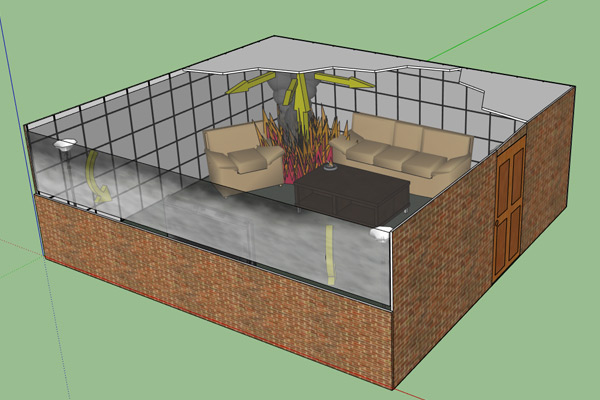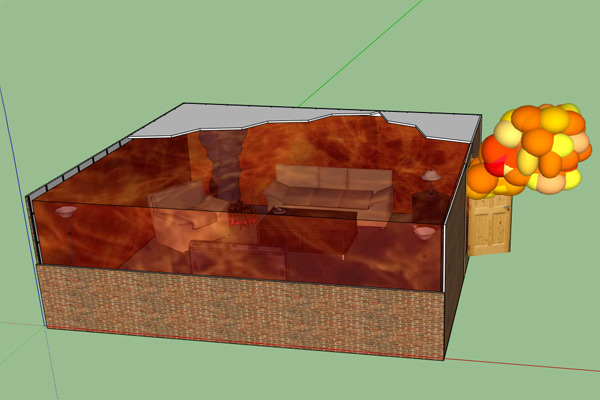Enclosure fire dynamics Augmented Reality (AR) experiment is the first of several upcoming Fire Science AR projects we are preparing for our Fire Science undergraduate students. In this AR lesson, Professor Greg Gorbett discusses the process of fire propagation in enclosed space (describes the ignition, fire growth, flashover and backdraft).
For this experiment we designed six scenes in Google Sketchup to depict different stages of enclosure fire dynamics (see images below).
- Scene 2
- Scene 3
- Scene 4
- Scene 5
- Scene 6
First scene depicts the 3d model of a room with several fuel packages such as polyurethane couch and chairs, doorway which will become important in later scenes as professor Gorbett talks about backdraft, and the initial stage of a fire – ignition (flames and smoke rising). In this scene we have fuel, heat and oxygen in the right proportions so the ignition has already occurred. Smoke rises as temperature of the gas increases and this increase of the temperature results in the increase of the volume of the gas. Increase in volume and keeping the same mass results in the lower density. That density difference compared from the hot gasses to the surrounding air results in lighter or buoyant forces to force these heated gasses upwards. That is how we get the smoke rising up. As the smoke rises upwards, it will rise and eventually stratify as it cools down. Since this is happening in an enclosed structure, the smoke will hit ceiling and create a ceiling jet. That ceiling jet is just the redirection of the flow of that thermal plume underneath the ceiling.
Scene 2: flames have gotten larger as they have spread and started to involve more fuel (couch, chairs). As the flames spread, more combustion takes place, more smoke is developing and rising up in the thermal column. As that thermal column starts to interact with the walls, we start to see the redirection of that ceiling jet downward (curved yellow arrows).
Scene 3: As the upper layer starts to form and descend from the ceiling, we start to see more and more smoke developing. Since the door in this compartment is closed, the pressure inside of the compartment will increase. As the ceiling layer begins to develop, we start to see involvement of additional fuels and more smoke developing. If that smoke has nowhere to go, it is going to descend as can be seen in the image below.
Scene 4: Upper layer is slowly descending and starting to interact and interrupt with the combustion process. This ignition interruption is caused by the lack of oxygen. Poor combustion results in insufficient combustion products which include carbon monoxide, carbon dioxide etc. Hydrocarbons also form due to the incomplete combustion and will later serve as a fuel during the backdraft fluctuation. In the model below, we can see that the fire is noticeably smaller due to the lack of oxygen.
Scene 5: With the full formation of the upper layer and with the increase of subtle pressure, a gravity current will form once the door of the compartment is opened. Gravity current is the cooler air from the outside which rushes in towards the bottom portion of that opening. What we have in-between those two currents is the incoming cooler air and outgoing heated gasses filled with hydrocarbons and carbon monoxide. That mixing allows for flammable limits to start forming. As soon as we have flammable limits, and those flammable limits reach the ignition source, we begin to see the backdraft event. This event will start near the ignition source and will start to propagate the flame through this suspended hydrocarbon fuel because of this insufficient fuel combustion.
Scene 6: When the flammable limits are met from the incoming rush of air and the mixing of the hydrocarbons, one can see the combustion reaction within the suspended fuel in the air. That is also called a propagating flame. If the mixture of fuel with the flame is continued, propagating flame will grow. Since all fluids follow the path of least resistance, fire propagation flow towards the open door. Pushed by the flame, tremendous amount of black smoke are being pushed outside of the compartment. This black smoke is than mixed with fresh oxygen and ignited by the flame front from behind. The result of this process is a large fireball (as seen in Scene 6). This is called a backdraft.
In this scenario (single compartment fire), there may be a tremendous amount of overpressure (possible flash fire outside event ). If the structure has multiple compartments and turbulence is allowed to increase the flame propagation along with the increase in pressure, what is going to happen is that the walls of this compartment are going to be blown off or the entire structure may be destroyed. These types of explosions is also called a backdraft and it has killed many firefighters.
Model Creation
This educational Augmented Reality model was designed Google SketchUp. Google SketchUp is simple to use and Google 3D marketplace offers myriad of free 3D models that can be imported into the scene you are designing. For example, if you are building a classroom and need a desk, you can click on the import models button in SketchUp, search for desk and once you select the one you like, you can import it into SketchUp.Once we built our base 3d model of a room, we added smoke, fire and various indicators to other 6 models.
We exported each modes in 3DS format (.OBJ works good as well), imported the models into BuildAR, re-sized them, adjusted the positions and saved the whole thing as a scene.We used BuildAR to run the scene and FRAPS to record the onscreen footage. The video below is the result
Download source files here (Enclosure_Fire_Dynamics 3D files, AR markers and marker PDF files).We posted a brief instructional video on how to open up a scene on YouTube: http://www.youtube.com/watch?v=f3C97PPTinE












